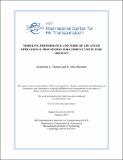| dc.contributor.author | Thomas, Jacqueline | |
| dc.contributor.author | Hansman, R. John | |
| dc.date.accessioned | 2017-02-06T19:11:05Z | |
| dc.date.available | 2017-02-06T19:11:05Z | |
| dc.date.issued | 2017-02-06 | |
| dc.identifier.uri | http://hdl.handle.net/1721.1/106874 | |
| dc.description.abstract | Increasing concerns regarding aircraft noise has encouraged the push to reduce noise via operational adjustments. The objective here is thus to expand analysis capabilities to enable modeling of the impact on aircraft noise due to advanced operational approach procedures, such as delayed deceleration approaches and thrust cutback scheduling on takeoff, for both current and future aircraft designs. Current industry standard noise models rely on flight test data interpolation and do not fully capture noise impacts from airframe configuration or advanced operational techniques. This is critical for noise assessment because airframe noise becomes a significant factor relative to the low thrust levels characteristic of advanced operational approaches. This method also limits the ability to assess new aircraft designs. Therefore, a new
method combining aircraft sizing and performance tools with NASA’s Aircraft NOise Prediction Program (ANOPP) has been developed to capture those noise impacts. ANOPP is used because of its capability of computing noise received at ground observers due to both engines and airframe of aircraft flying any flight procedure. Inputs into ANOPP are the aircraft geometry, the flight procedure, and the engine performance during the flight procedure. The Transport Aircraft
System OPTimization (TASOPT) model is used to compute the engine performance inputs into ANOPP via first principles, physics-based methods. A separate tool was developed to compute the specifics of the flight procedure (max glide slope obtainable for a particular velocity and configuration, required thrust levels, etc.) based on drag polar supplied either by the Base of
Aircraft Data (BADA 4) for current aircraft or by TASOPT for new aircraft. Benefits of this modeling framework include the flexibility in the aircraft and procedure analyzed and the ability to predict the noise of future aircraft configurations without relying on existing data. Both the noise impacts of a sample advanced operational flight procedure and in a future aircraft fleet
have been assessed with this model. Next steps include further use of this model to evaluate the noise benefits or detriments of advanced operational approaches. | en_US |
| dc.description.sponsorship | This work is funded by the US Federal Aviation Administration (FAA) Office of Environment and Energy as a part of ASCENT Projects 11 and 23. Any opinions, findings, and conclusions or recommendations expressed in this material are those of the authors and do not necessarily reflect the views of the FAA or other ASCENT Sponsors. | en_US |
| dc.relation.ispartofseries | ICAT;2017-01 | |
| dc.subject | aircraft noise | en_US |
| dc.subject | approach procedures | en_US |
| dc.subject | airframe configuration | en_US |
| dc.subject | air transportation | en_US |
| dc.title | Modeling Performance and Noise of Advanced Operational Procedures for Current and Future Aircraft | en_US |
| dc.type | Technical Report | en_US |
